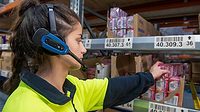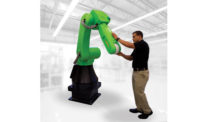Voice-picking technology continues to grow, innovate
SKU proliferation drives growth and innovation

S&PS’ Bruce Stubbs says voice technology has seen advances in hardware making both the device itself and the headset more ergonomic and user friendly. (Image courtesy of Honeywell Sensing and Productivity Solutions)
The ever-increasing number of SKUs within the beverage industry has been one obstacle beverage warehouse operators have been facing the
past several years. However, the proven benefits of, and further innovations to, voice-picking technology has made it a staple in many beverage distribution centers today.
“The demand for voice technology has only continued to increase, as more distributors recognize the benefits, and as they continue to take on more and more SKUs in their portfolios,” says Larry Edelson, marketing director for Vermont Information Processing (VIP), Colchester, Vt.
“… [T]he proliferation of voice has permeated the labor pool such that managers, floor-level employees and even temps now arrive on site ‘voice-ready,’” adds Steve Hoffman, fulfillment specialist for Dematic Corp., Grand Rapids, Mich. “Voice is becoming more mainstream.”
According to Hoffman, for almost a decade, voice in beverage applications has been driven most strongly by productivity, accuracy, visibility and control.
Keep ‘em comin’
Industry suppliers say productivity and accuracy are the two biggest benefits of voice technology. “Productivity issues always seem to be mentioned first when voice is discussed in beverage, but I think that accuracy is equally, or more, important,” Hoffman says. “Combining voice with a UPC scan assures that the correct item is selected for picking.”
Unlike other warehouse technologies, voice technology offers a quick return-on-investment (ROI), which makes it valuable to teams of any size. “Voice technology immediately provides a number of benefits, as well as an incredibly fast ROI,” VIP’s Edelson says. “Most of our customers conservatively report that the investment in voice technology pays for itself within the first 12 months.”
Bruce Stubbs, director of industry marketing for Honeywell Sensing and Productivity Solutions (S&PS), Minneapolis, notes: “Due to the focused, hands-free nature of voice applications, it has also been shown to improve safety, ergonomics and morale in the workforce, which reduces costs associated with injuries, damage to equipment, facilities and product, and employee turnover.”
Hoffman adds that morale is increased by individual reward systems developed from the metrics provided by the technology. “This benefits the employee directly, but rewards the employer with lower turnover and training costs,” he says.
VIP’s Edelson notes that a distributor experiencing high turnover rates, or struggling to find workers, can benefit from voice technology. “Voice makes the training process much faster, improves retention and boosts morale,” he says. “Voice picking makes peoples’ jobs easier.”
Always improving
According to S&PS’ Stubbs, voice technology has seen advances in hardware — making both the device itself and the headset more ergonomic and user friendly. “The new headsets are more ergonomic and provide the end user with the hygienic options desired,” he says. “This advancement also provides lower [total cost of ownership] (TCO) for the company as the chargeable portions of the headset can be shared across multiple users.”
From a software standpoint, advancements have been made within the conversations between the worker and the technology. “Voice technology has become more advanced since its introduction, with better speech recognition technology that allows workers to speak naturally,” explains Chris Castaldi, director of business development for W&H Systems, Carlstadt, N.J. “Voice technology understands more dialects and accents.”
Not only is voice technology understanding more dialects and accents, it also is functioning in many different languages, Stubbs says. “Voice is now available in so many languages that it is truly a global solution, especially effective for global operations that realize the benefit of deploying a common technology across their supply chain enterprise,” he says.
Stubbs adds that multilingual workforces can benefit most from the proliferation of languages available. “Voice is also now available in more than 35 languages,” he explains.
He says that multilingual workforces benefit from voice technology that uses their native languages for both training and providing tasks.
Looking for a reprint of this article?
From high-res PDFs to custom plaques, order your copy today!







